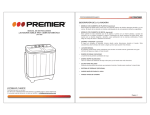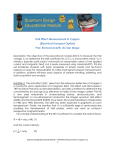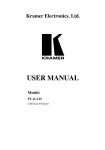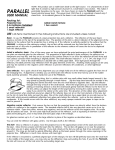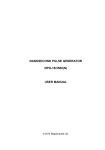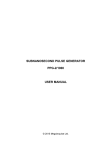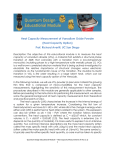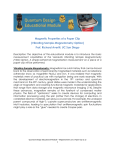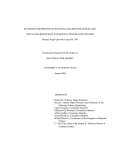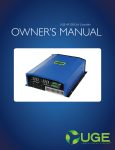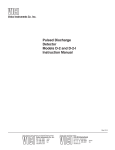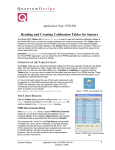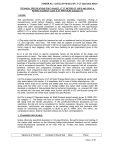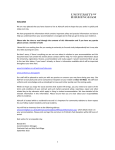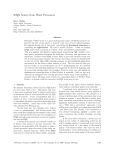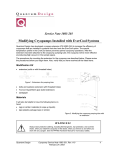Download This Experiment! - Quantum Design Education
Transcript
Hall Effect Measurement in Germanium (Electrical Transport Option) Prof. Richard Averitt, UC San Diego Description: The objective of this educational module is to measure the Hall effect germanium and determine the carrier concentration (and type) as a function of temperature. Germanium is an indirect bandgap semiconductor with a room temperature bandgap EG = 0.67 eV. As discussed in the module on Hall effect measurements in Cu, the Hall coefficient RH is given by the following equation: RH = VHt/IB = 1/ne (1) Recall that when electrons are the charge carriers, RH is negative and when holes are the charge carriers, RH is positive. Typical carriers densities in semiconductors are orders of magnitude lower than in metals (typical values range from ~1014 to 1018 cm-3). Thus, RH can be orders of magnitude larger in semiconductors in comparison to metals. The correspondingly large Hall voltage (VH = RHIB/t) enables semiconductors to be used as low-cost magnetic field sensors with numerous applications1. More generally, HE measurements provide a powerful means to characterize semiconductors, an important task given the ubiquity of semiconductor devices in virtually every aspect of modern technology. Hall voltage measurements, in combination with resistivity measurements (with certain caveats – see below), suffice to determine both the carrier density and mobility. The mobility (typically denoted µ) characterizes the drift velocity, that is v = µE where v is the drift velocity and E is the applied electric field. Mobility values are typically presented in terms of cm2/Vs – for example in GaAs, the electron mobility at room temperature is ~8500 cm2/Vs, whereas for holes the mobility is ~400 cm2/Vs. In Ge, the numbers are ~3900 and 1900 cm2/Vs for electrons and holes, respectively2. The larger the mobility the greater the conductivity since σ = neµ, along with a correspondingly smaller resistivity: Quantum Design Educational Module – Hall Effect Measurement in Germanium (v.1) 1 ρ = 1/σ = 1/ neµ (2) A glance at Eqns. (1) and (2) shows that these determining RH and ρ allows for the determination of n and µ. These equations are a simplification, and would be appropriate for a material where either electrons or holes are the dominant carriers. In semiconductors, both electrons and holes can simultaneously contribute to the transport, and they must be treated, initially at least, on equal footing. A basic understanding of this can be obtained from considering Figure 1. The defining characteristic of semiconductors is the existence of a nonzero bandgap with typical values on the order of 1 eV. For an intrinsic semiconductor as depicted in Fig. 1(a) (i.e. one without intentional doping), this leads to a small carrier density that is determined via thermal activation across the gap. Intuitively, the larger the gap, the smaller the carrier density at a given temperature. For intrinsic semiconductors, for each electron thermally excited across the gap into the conduction band, there is a corresponding hole in the valence band, both of which contribute to the transport properties of the material – this is often termed ambipolar transport. Consideration of electrons and holes to the transport leads to the following expression for the Hall voltage: 𝑉𝑉𝐻𝐻 = 2 𝑝𝑝𝑝𝑝ℎ −𝑛𝑛𝑛𝑛𝑒𝑒2 𝑒𝑒(𝑝𝑝𝑝𝑝ℎ −𝑛𝑛𝑛𝑛𝑒𝑒 )2 𝑝𝑝−𝑛𝑛𝑛𝑛2 = 𝑒𝑒(𝑝𝑝+𝑛𝑛𝑛𝑛)2 (3) In this equation, p (n) is the hole (electron) carrier density, µp (µe) the corresponding hole (electron) mobility, and θ = µe/µh. Eqn. (3) highlights that the Figure 1: schematic of semiconductor with energy gap EG. a) For an intrinsic semiconductor (i.e. undoped), the Fermi energy EF (more properly, the chemical potential) is at ½EG. b) The addition of donors with binding energy ED increases the conduction band carrier density (electrons) while doping with acceptors with binding energy EA, increases the valence band carrier density (holes). Doping leads to a shift of EF away from midgap. Quantum Design Educational Module – Hall Effect Measurement in Germanium (v.1) 2 situation is more complicated for ambipolar transport3. However, quite often semiconductors are doped with atoms to create extrinsic semiconductors. The addition of donors (e.g. P or As in Ge, see Fig. 1 (b)) adds additional electrons to the conduction band at temperatures sufficient to ionize the donor impurities. Similarly, the addition of acceptors (e.g. B or Al in Ge, see Fig. 1(c)), adds additional holes to the valence band at temperatures sufficient to ionize the acceptor impurities. If the dopant density is sufficiently larger that the intrinsic carrier density then Eqn. 3 simplifies. For example, if the acceptor dopant density is such that 𝑝𝑝 >> 𝑛𝑛𝜃𝜃 2 , then Eqn. 3 simplifies to the conventional form (i.e. Eqn. 1, note however, we now have separate symbols – 𝑝𝑝 for holes and 𝑛𝑛 for electrons). It is important to emphasize that temperature plays a key role because of the thermal excitation of carriers across the gap and because of donor thermal ionization. A given doped semiconductor could exhibit extrinsic behavior at room temperature with a crossover to intrinsic behavior with decreasing temperature because of dopant freeze-out (i.e. below the temperature where there is appreciable dopant ionization). A crossover to intrinsic behavior could also occur at higher temperatures because of thermal excitation of carriers across the gap in excess of the dopant density. Temperature dependent HE measurements enable the determination of this behavior. Excellent discussions of the statistical mechanics of carrier density in intrinsic and extrinsic semiconductors can be found in the notes4. Versalab can be used to measure the Hall effect and the resistivity. However, in this module, we will focus on Hall measurements of p-doped Ge as a function of temperature. It may be useful to go back and review the Cu Hall Effect module as it contains complementary information. Notes: 1. Hall-Effect Sensors: Theory and Application, E. Ramsden, Elsevier, Amsterdam 2006. 2. An excellent online source for the properties of numerous semiconductors can be found at http://www.ioffe.ru/SVA/NSM/Semicond/ 3. It is worth mentioning at this point that a more complete analysis of the Hall Effect must treat the statistical nature of the carrier velocity, leading to prefactor in Eqn. 1 or 3 that is ~1. 4. Chapter 8 of Introduction to Solid State Physics, 7th edition, C. Kittel, Wiley and Sons, New York 1996; Chapter 28 of Solid State Physics, N. W. Ashcroft and N.D. Mermin, W.B. Saunders, Philadelphia 1976; Chapter 1of Physics of Semiconductor Devices, S.M. Sze, Wiley & Sons, New York 1981. Instructions: In this section, we will provide details on sample preparation and, subsequently, performing the HE measurement using the VersaLab/ETO. We note that the approach is similar to the Cu Hall effect measurements, but we there we will take a slightly different approach if for no other reason to point out alternatives. Quantum Design Educational Module – Hall Effect Measurement in Germanium (v.1) 3 Several items are needed for this experiment, which includes: • • • • • • • • • • A piece of semiconductor wafer. In the present case, we are using a ptype doped Ge wafer, but other samples that you may have access will work. You may need a caliper to measure the semiconductor sample thickness. In our case, the sample wafer is 500 microns thick as measured by the vendor. Diamond scribe to assist in cleaving the semiconductor sample Cotton swabs and acetone to clean the semiconductor surface Silver paste and thin gauge wire Kapton tape and apiezon N grease Tweezers, toothpick (for spreading H grease) Latex or nitrile gloves for sample handling ETO transport puck Puck wiring test station and ohm meter (to test continuity of silver paste joints) Prior to performing the HE measurement with the VersaLab/ETO, it is important to prepare the sample as detailed in the following steps: a.) First, it will be important to obtain an appropriate sized sample that can fit within the sample puck. In our case, we had available a 2” diameter ptype Ge wafer as shown in Figure 2. Figure 2: p-type Ge wafer b.) Using a diamond scribe, score the wafer as shown in Figure 3. Quantum Design Educational Module – Hall Effect Measurement in Germanium (v.1) 4 Figure 3: Score the wafer with a diamond scribe c.) Place the wafer with the scribed line along a straight edge such as a microscope slide and press gently. The wafer should break along the scribed line as shown in Figure 4. Repeat this process along the orthogonal directions until you have a square sample. Other approaches may be more precise depending on the equipment available in your lab (e.g. wafer saw). Figure 4: Cleaved Ge wafer d.) The sample should be cleaned with acetone prior to mounting on the wafer puck and wiring up. e.) For this sample we, instead of soldering we will attach the leads using silver paste (Fig. 5). A sharp tip such as a syringe will be useful to precisely locate the soldering paste and wires. For good adhesion to the wafer, we first used the diamond scribe to gently scratch the area where the silver paste will be applied. The process is quite similar to soldering as described in the Cu Hall Effect module. Quantum Design Educational Module – Hall Effect Measurement in Germanium (v.1) 5 Figure 5: Silver paste and syringe for sample contacts f.) Let the silver paste dry for ~20 minutes before handling the sample. g.) While the silver paste is drying, the puck can be prepared. Cut a small sample of kapton tape (see Figure 6) and apply it to the sample puck (this will serve as elelctrical insulation similar to the cigarette paper in the Cu HE module). Figure 6: Kapton tape as insulation h.) Apply a thin layer of apiezon N grease to the kapton. This is to adhere the sample to the puck. Importantly, N-type grease is appropriate for going to low temperatures as will be performed later in this experiment. i.) Place the sample on the puck and use the silver paste to connect the wires to channel 2. Again, let the sliver paste dry for a sufficient amount of time prior to making measurements. Note: we have used silver paste down to 50K in the VersaLab without any problems and with out baking the sample to drive off the volatiles from the silver paste. It appears that drying at room temperature is sufficient. j.) As shown in Figure 7, the puck wiring test station provides a convenient means to check the continuity of the soldering prior to insertion into the VersaLab instrument. In the Cu HE, the resistance was less than 1 Ohm. This Quantum Design Educational Module – Hall Effect Measurement in Germanium (v.1) 6 need not be the case for the semiconductor and as Fig. 6 shows, for our sample the resistance is ~0.9 kΩ. Figure 7: Checking sample for continuity k.) At this point the transport puck/Cu foil is ready to be inserted into the VersaLab. This is accomplished using the puck insertion tool as described in the VersaLab user’s manual (Figure 1-2). Upon inserting the puck, it is important to make sure the tab on the transport puck is properly aligned. The tab should face towards the front of the VersaLab, and it is possible to feel a slight click. At this point gentle downward pressure will allow for appropriate seating of the sample puck into the sample chamber. l.) The sample chamber can be sealed by inserting the baffle set (don’t forget the o-ring) and Kwik-Flange clamp. The rest of this experiment will utilize the MultiVu software. Please see Chapter 3 of the VersaLab manual and Chapter 4 of the ETO manual for complete details. Moreover, the sequence is similar to the Cu Hall Effect, so please refer to steps m.) – v.) of the Cu HE module. m.) One difference is that for the Cu HE, we used a current of 100mA. That is more than required for these measurements. Try using 1mA to determine if that is sufficient to obtain a good signal. That is what we used for the measurements of our p-type Ge Sample. n.) The measurement you performed was at room temperature. As per the discussion above, we expect the carrier concentration to change as a function of temperature. We will manually cool the sample to 150K (i.e. not using a sequence). To do this, right click in the temperature box in the lower left corner of MultiVu. This will pull up the dialog box. Enter 150K, with a cooling rate of 10K/min and push set. Wait for the temperature to stabilize. Quantum Design Educational Module – Hall Effect Measurement in Germanium (v.1) 7 o.) Repeat the measurement at this temperature. This process could be repeated at several temperatures. It is also possible to write a sequence to fully automate this process. p.) In Figure 7, we show our data for the p-type Ge sample. As can be seen the slope, as expected is opposite to Cu, and there is a change in slope consistent with a change in the carrier density. It is possible to analyze this data to determine the carrier concentration. This data has been processed to subtract off the residual longitudinal resistance. q.) Finally, when you are finished set the temperature back to 300K and reduce the field to 0 Oe. Figure 8: Hall measurements in p-Ge sample: black 300K, red 150K Questions / Analysis: Some of the following questions are specific to the data that was obtained, while others are of a more open-ended or comparative nature. 1. In semiconductors, it can be a challenge to make a good ohmic contact. Instead, as Schottkey barrier can result. Investigate and discuss the origin of Schottkey barriers. Identify some approaches that have been used to eliminate Schottkey barriers and achieve a good ohmic contact. How would you use the VersaLab to determine if you have an ohmic or Schottky contact? Do you expect have a non-ohmic contact to strongly affect the Hall measurement results? 2. Measure the resistivity of your sample and use this, along with the Hall measurement, to obtain and estimate of the mobility and carrier density. Discuss any approximations that you make. Look in the literature to determine the most accurate techniques available for such measurements (note: you need not implement these more accurate techniques). 3. Write a sequence to automate the Hall Effect measurements as a function of temperature. Measure your sample at ten or more temperatures and use this data to make a plot of the carrier density versus temperature. Qualitatively describe the temperature dependence of your sample. Is there evidence for carrier freeze Quantum Design Educational Module – Hall Effect Measurement in Germanium (v.1) 8 out (i.e. do you go to temperatures sufficiently low that you don’t ionize the impurities?) Some of these questions can be very sample dependent so you may need to think carefully about your results with regards to the room temperature dopant density, etc. 4. What does the change in slope between the 300K data and 150K data in Figure 7 suggest? That is, is this data in line with your intuitive expectations for what should occur upon cooling? 5. Either derive or find a derivation of Equation 3 for the Hall voltage when electron and holes both contribute to the transport. Quantum Design Educational Module – Hall Effect Measurement in Germanium (v.1) 9









